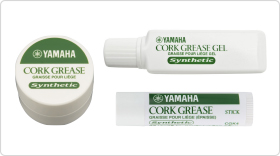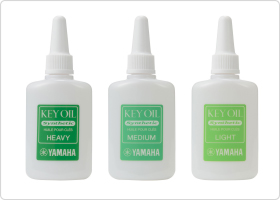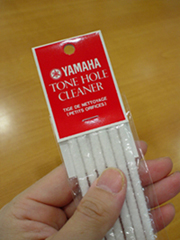Care and Maintenance of a Bassoon
How to use maintenance accessories
Don't use too much cork grease!
Before assembling the instrument cork grease should be applied to the joint cork, but applying too much can be counterproductive. It is best to take care not to apply too much cork grease.
There are some musicians who apply cork grease every day without fail, but if the cork is constantly in contact with the grease it may absorb it. If this occurs, the adhesive between the cork and the instrument body may be dissolved, and the cork may become worn and fall off. Furthermore, as the grease is sticky, dust may adhere to the cork if the instrument is placed in the case in this condition. If the bassoon is assembled or separated with dust on the cork, the risk of damaging the instrument is a concern.
The best way to use the grease is to apply it to areas of the cork that feel stiff while assembling the instrument, and then to wipe the grease away when the instrument is separated after use before placing it in the case. With this approach, dust does not attach to the instrument, and not putting it away while freshly greased prevents the grease from being absorbed by the cork. It is a good habit to adopt.

Cork grease
How to make pads last longer
As the pads are a particularly delicate part of the instrument that deteriorate due to wear and moisture, it is necessary to replace them every few years. However, if they are well maintained they will remain in the best condition for every performance, and their life span can be extended. It is best to maintain them as thoroughly as possible.
The most significant factor that causes shortening of the life span of the pads is moisture. If pads are allowed to remain exposed to moisture for an extended period they will quickly deteriorate, so it is important to wipe away any moisture held in the pads before returning the instrument to its case after performances. This can be done with cleaning paper.
Cleaning paper is very similar to cosmetic blotting paper, with sheets that can be separated for individual use. After playing, hold paper between each pad and tone hole, and lightly press the key a number of times to soak up any oil or moisture. As the keys don't all accumulate moisture at the same rate, the priority is to focus on keys that are a concern. If you are concerned about stickiness, the instrument can be stored in the case with cleaning paper between the pads and the tone holes.

Cleaning paper
Key oil fundamental to maintenance
Although it is known that key oil is fundamental for woodwind instruments, the number of people who diligently apply key oil appears to be surprisingly low. As the keys are the most important part of a woodwind instrument, it is beneficial to get into the habit of applying key oil as needed.
Key oil works to protect the metal surfaces of the keys. When applied, it spreads between the metal surfaces to form a thin oil film. This film provides lubrication, preventing direct metal to metal contact and facilitating a smooth movement. As friction is reduced and the metal doesn't rub, wear is also minimized. Furthermore, as the film protects the metal from exposure to moisture and the air, it is possible to protect against corrosion and rust (of course, take care to avoid over-application).

Heavy key oil (left) for use with bassoons
Noise between metal parts that rub against each other directly when the keys are moved during performances is one further problem that can occur when oil is not applied. Clattering noise during play can make the sound unpleasant to listen to, and make concentration difficult for the bassoonist. Further deterioration may cause the keys to develop wobble, preventing them from covering the tone holes completely. If the problem becomes this severe it is likely that substantial repair work will be required. To avoid such a situation some conscientious bassoonists apply key oil at least once a fortnight, and all should be sure to apply key oil at least once a month.
Yamaha produces three types of key oil. The light key oil is suitable for piccolos, flutes, oboes and similar instruments. The medium rated oil is recommended for clarinets, while the heavy oil is intended for saxophones, bass clarinets and bassoons. As the viscosity varies between different types, take care to use the correct type for your instrument.
Regular care for tone holes
Specially made tone hole cleaners can be used for maintenance of the tone holes. The core of a tone hole cleaner is made of wire, while the surface is covered with a soft fabric such as chenille. It can be bent into an easy-to-use shape, and inserted into the interior of the instrument via the tone hole. If used on the interior edges of tone holes in the body of a woodwind instrument, fine dust can easily be collected, and it is good to pay particular attention to cleaning these areas.
In fact, this is not the only way to use tone hole cleaners. They can also be very effective at removing any dust that has accumulated in the many areas that have complex detail around the keys on the outer surface of the instrument. Dust can easily gather here in the areas around the keys because of the presence of key oil, and if it is not removed it can affect the movement of keys and their feel during use. If substantial build-up develops, debris can become caught in the mechanism, causing the cover to no longer close fully or other problems to occur, which then make more significant maintenance work necessary. It is best to ensure that dust is regularly cleaned from the bassoon.

Tone hole cleaner
Musical Instrument Guide : Bassoon Contents
Structure
- What Kind of Musical Instrument is a Bassoon?
- A Long Tube that can be Separated
- The Bocal and its Various Functions
- Unique Features of the bassoon, and How to Play
- [Experiment1]Comparing the Sound of Tone Holes cut Obliquely and Perpendicular
- [Experiment2]Encasing the Bore in Various Materials
- Bonus Experiment
How to Play
How the Instrument is Made
Choosing an Instrument
Trivia
- An Instrument that is Sensitive to Humidity
- Sounds from water in the U-tube?
- There's a needle in the bocal?!
- Comments by conductors caused popularity to tumble?
- Bassoon classics - Chamber music works
- Bassoon classics - Concertos
- Is the "contra-fagotto" a contrabassoon?
- What is the best tool to file a reed?
